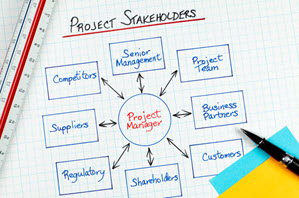 I am usually very energized by a new project. After all, there is a customer out there who is waiting to get started, eager to meet with me, and may have already left a couple of voice mails for me before I ever get the project officially handed off to me. I had one – US Airlines to be exact – who wanted a finish date for a software implementation I was going to be doing for them before we even met by phone so that they could put it in some airline industry publication. Talk about enthused. Or at least being pushed by someone higher up to look and act enthused.
I am usually very energized by a new project. After all, there is a customer out there who is waiting to get started, eager to meet with me, and may have already left a couple of voice mails for me before I ever get the project officially handed off to me. I had one – US Airlines to be exact – who wanted a finish date for a software implementation I was going to be doing for them before we even met by phone so that they could put it in some airline industry publication. Talk about enthused. Or at least being pushed by someone higher up to look and act enthused.
When you are used to that type of anticipation from the customer – or something close to that – it’s no wonder we can become frustrated when the indecisiveness – or lack of availability from a project sponsor gets in the way of forward momentum on an engagement…or even just getting it kicked off. When that indecision is coming from your direct customer, it cannot only be frustrating, but also very detrimental to the project. Every project manager knows all too well that delays caused by waiting on key decisions and input can cost time and money – two things that few projects have extra of.

 What skill must every project manager possess in order to be successful? Communication. Good, effective, efficient communication. Going into any engagement who the project manager will be communicating with is a question mark because the project itself can be more far reaching than originally imagined. And even if it isn’t much of who will actually be involved – in terms of stakeholders – will get finalized during the kickoff session (although more will usually be added along the way). At a minimum, that communication will be with the project manager’s project team, his senior management, the customer sponsor, the customer project team, possible senior leadership at the customer site, and possibly third party vendors. There even may be more stakeholders than what’s included – they do tend to get added along the way. They may even come and go throughout the project. The constant, though, is that those communication skills must be there and remain engaged throughout the project.
What skill must every project manager possess in order to be successful? Communication. Good, effective, efficient communication. Going into any engagement who the project manager will be communicating with is a question mark because the project itself can be more far reaching than originally imagined. And even if it isn’t much of who will actually be involved – in terms of stakeholders – will get finalized during the kickoff session (although more will usually be added along the way). At a minimum, that communication will be with the project manager’s project team, his senior management, the customer sponsor, the customer project team, possible senior leadership at the customer site, and possibly third party vendors. There even may be more stakeholders than what’s included – they do tend to get added along the way. They may even come and go throughout the project. The constant, though, is that those communication skills must be there and remain engaged throughout the project.
 I am a consulting project manager rather than one working directly for an organization. So this article may be a bit more applicable to the consultant who has more options to turn down projects (although income is essential and nice). Working as a W2 employee – or even as a contractor within the organization – I don’t think I’ve ever really had the option to say no to a project that was assigned to me…but then again I don’t think I ever tried to say no. If you’re not a consultant and do have the right of first refusal when assigned new projects, then this article is also for you. Independent consultants can say yes or no – but if you want income and don’t want to burn bridges with potential clients in the future, you want your no’s to be for good reason….and infrequent.
I am a consulting project manager rather than one working directly for an organization. So this article may be a bit more applicable to the consultant who has more options to turn down projects (although income is essential and nice). Working as a W2 employee – or even as a contractor within the organization – I don’t think I’ve ever really had the option to say no to a project that was assigned to me…but then again I don’t think I ever tried to say no. If you’re not a consultant and do have the right of first refusal when assigned new projects, then this article is also for you. Independent consultants can say yes or no – but if you want income and don’t want to burn bridges with potential clients in the future, you want your no’s to be for good reason….and infrequent. You’re an experienced project manager with many project success stories under your belt. Likewise, you’ve had enough failures…or brushes with failure…to be able to understand that side of the coin. You have the ability to talk about what works well on projects and what doesn’t work so well. What makes project clients happy and what makes them not so happy. You’ve done things right…and you’ve occasionally done things wrong…and learned something from those poor choices, decisions and actions. Overall, these PM experiences…both good and bad…make you a good mentor for a junior project manager or perhaps an aspiring project manager from inside your organization.
You’re an experienced project manager with many project success stories under your belt. Likewise, you’ve had enough failures…or brushes with failure…to be able to understand that side of the coin. You have the ability to talk about what works well on projects and what doesn’t work so well. What makes project clients happy and what makes them not so happy. You’ve done things right…and you’ve occasionally done things wrong…and learned something from those poor choices, decisions and actions. Overall, these PM experiences…both good and bad…make you a good mentor for a junior project manager or perhaps an aspiring project manager from inside your organization.
 Control. It drives professionals to success or an early grave…depending on the individual and the obsession. But there is no question that some of the most successful project managers thrive on it. Let’s face it – there is a lot to manage on a project – including some big egos – so it’s imperative that a project manager be able to maintain control of the project and those egos if they want (hope?) to realize success.
Control. It drives professionals to success or an early grave…depending on the individual and the obsession. But there is no question that some of the most successful project managers thrive on it. Let’s face it – there is a lot to manage on a project – including some big egos – so it’s imperative that a project manager be able to maintain control of the project and those egos if they want (hope?) to realize success.

 When we are assigned a new project there are plenty of things to do, right? First, that frantic wave comes over you as you consider the work that is already on your plate and you think about how you are going to manage to insert this new project assignment into the workload that you are already carrying. Then you start to think about the usual processes you go through to start a project like gathering as much info about the project and customer as you can, how and when you’re going to kick off the project and what your project team will need to look like in terms of skill set and experience.
When we are assigned a new project there are plenty of things to do, right? First, that frantic wave comes over you as you consider the work that is already on your plate and you think about how you are going to manage to insert this new project assignment into the workload that you are already carrying. Then you start to think about the usual processes you go through to start a project like gathering as much info about the project and customer as you can, how and when you’re going to kick off the project and what your project team will need to look like in terms of skill set and experience. In
In 